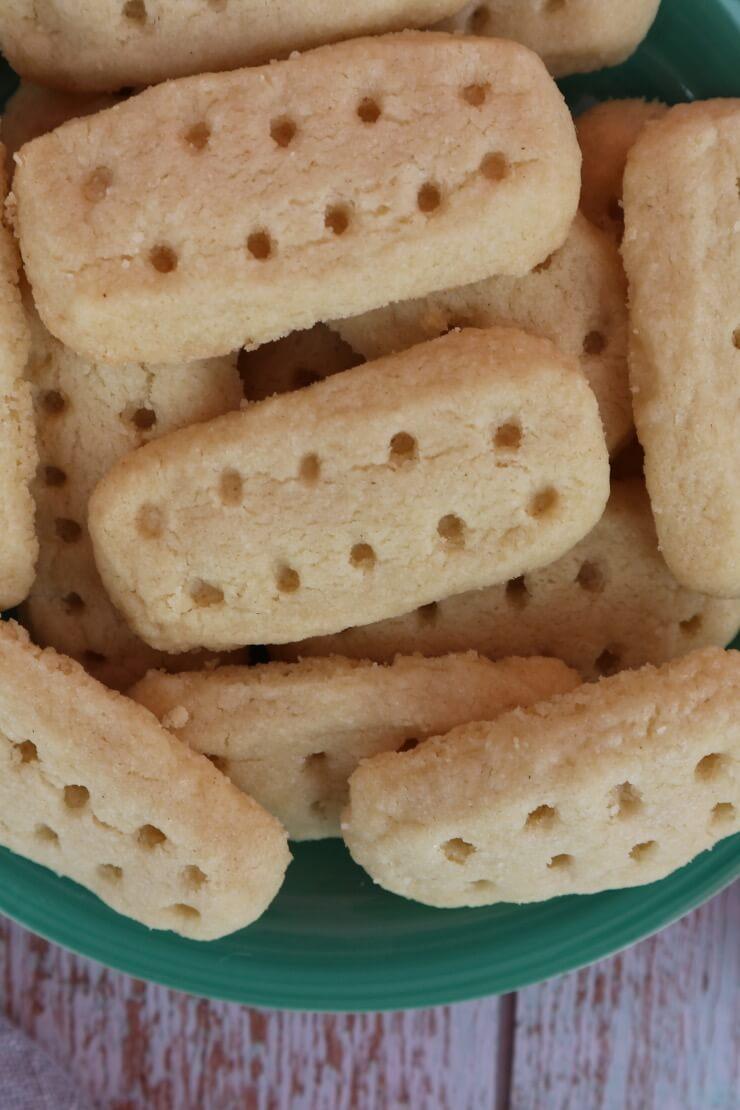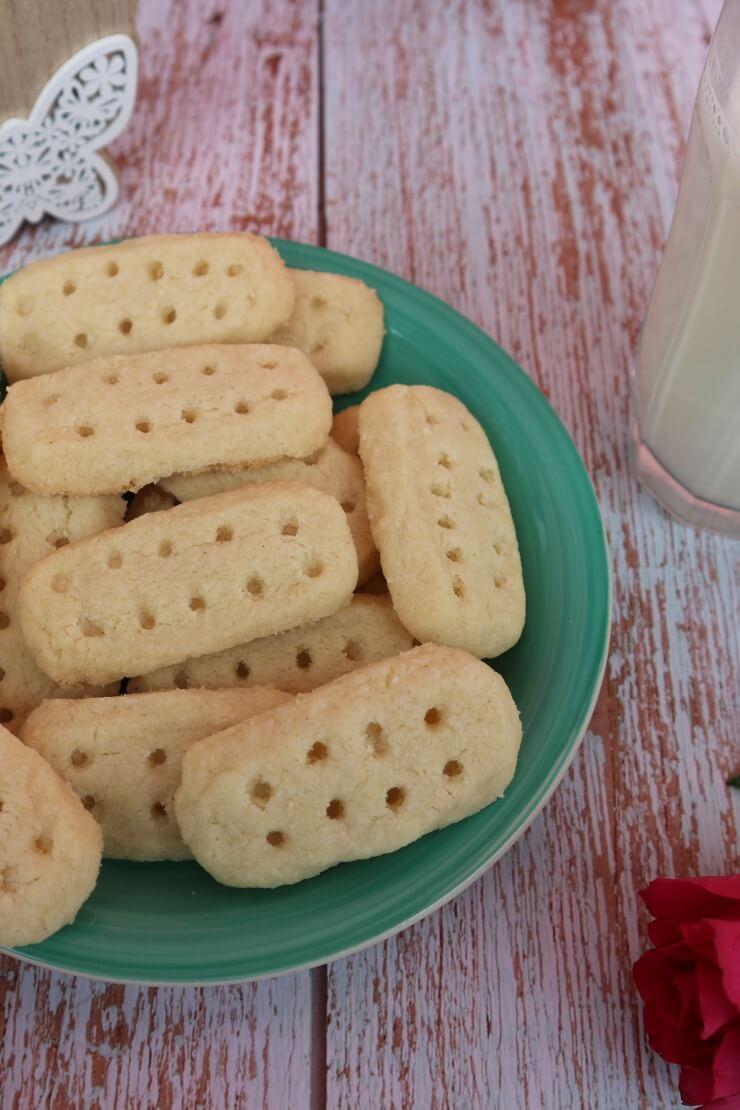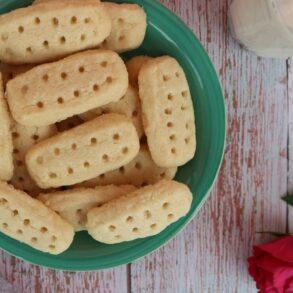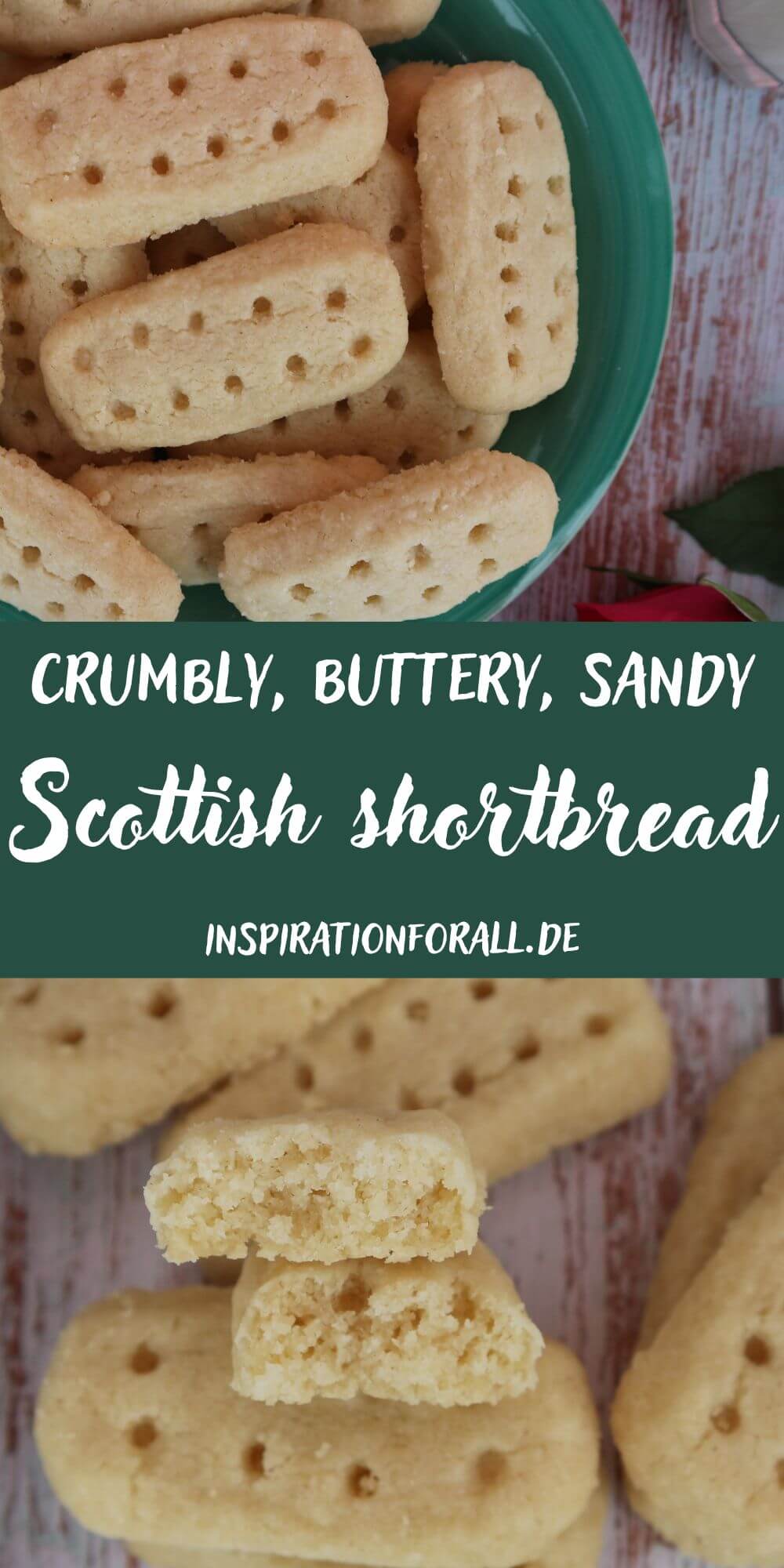Dieser Beitrag ist auch verfügbar auf:
Deutsch
Incredibly crumbly, fluffy, sandy, buttery and delicious is the Scottish shortbread. Very simple and with very few ingredients you can make the famous shortbread cookies from Scotland yourself. They are not only suitable for Christmas, but taste delicious all year round. A detailed Scottish shortbread recipe with exact quantities and step-by-step instructions can be found below.

What is Scottish shortbread?
Scottish shortbread are popular Scottish shortbread cookies. The dough for them consists of butter, sugar, flour and a little salt. It does not contain eggs.
The classic Scottish shortbread has a sandy taste and a pale color.
In Scotland, the shortbread is especially popular at tea time. In the meantime, it has become popular not only throughout Great Britain, but all over the world.
Rice flour – the secret of Scottish shortbread
The secret of Scottish shortbread is rice flour**. The shortbread dough for the cookies is made not only with wheat flour, as is the case with ordinary German cookies, such as Heidesand cookies. For the Scottish pastry you take a mixture of wheat and rice flour.
It is rice flour that gives Scottish shortbread its typical sandy texture. So it’s best not to substitute wheat flour for the rice flour in the recipe below.
Proportions between ingredients
The traditional Scottish shortbread recipe adheres to certain proportions when it comes to ingredient amounts. For this, you take one part sugar, two parts butter, and three parts flour. As I mentioned earlier, this involves replacing one part wheat flour with rice flour.
Don’t forget to add a good pinch of salt to the dough. Salt actually enhances the flavor of the cookies. I used a quarter teaspoon of salt for my recipe.

How to shape Scottish shortbread?
The Scottish cookies are traditionally made in three different shapes. Depending on your taste you can choose one of them.
Fingers
As you can see on the pictures, I chose this shape. For this, you shape the dough into a 1 cm thick plate. After cooling, you cut it into long rectangles (about 6 cm long and 2 cm wide) – fingers.
Rounds
As the name suggests, these are round cookies. Shape the dough into a Ø 4 cm – 5 cm thick roll. After cooling, cut them into slices about 1 cm thick.
Petticoat tails
With this shape, the cookies look like pieces of cake. You shape the dough into large plates about 1 cm thick. After cooling, cut each plate into triangles only, like a pie. Then, after baking, cut them all the way through.
Vegan Scottish shortbread fingers
Since the Scottish shortbread dough does not contain eggs, it is very easy to make the cookies vegan. Just replace animal butter with vegan butter or margarine.
I used German Alsan Bio for the recipe. So my Scottish shortbread fingers are vegan.

The best baking temperature
When looking at Scottish shortbread recipes on the Internet, one comes across all kinds of baking temperatures. At from 160 ° C to even 200 ° C, the Scottish cookies are baked.
I have tested different baking temperatures. The best Scottish shortbread I succeeded at 160 °C top and bottom heat.
The cookies baked at 180 °C were okay. However, they tasted less tender than those I baked at 160 °C. The cookies baked at 200 °C were a bit dry and not as fine. They even got a slightly brown edge. And actually, classic Scottish shortbread needs to look pale.
Since every oven bakes differently, you’ll have to go with your oven. The important thing here is not to bake the cookies too long. Otherwise, they might not taste as crumbly.
For tea, as a gift or for Christmas
Scottish shortbread tastes delicious at any time of the year. Snack on it plain or serve it with tea, coffee or (plant) milk for dessert.
Of course, the Scottish cookies pass perfectly as Christmas cookies. Fill your cookie plate with them, in addition to angel eyes cookies, snowflake cookies, spritz cookies, vanilla crescents, Spitzbuben.
Plus, the Scottish pastry is ideal for gift giving. As a homemade gift from the kitchen, it is guaranteed to delight your loved ones.
Store the pastry in airtight packaging, for example in a lunch box or cookie tin**. You can store it at room temperature for several weeks. However, the cookies will definitely not last that long.

Different flavors
In addition to the classic Scottish shortbread, the pastry is available in various flavors. For example, you can refine the dough with a little cinnamon**, ginger powder** or cardamom. Gingerbread spice makes the Scottish pastry the real Christmas cookies.
Add some fresh orange or lemon zest for a special aroma and refreshing taste.
If you’re a chocolate fan, you can drizzle the shortbread cookies with chocolate glaze after baking.
These Scottish shortbread fingers are
- crumbly,
- buttery,
- sandy,
- fluffy,
- fine,
- tender,
- heavenly delicious,
- vegan from me,
- easy to make with a few ingredients,
- ideal for dessert with coffee or tea, as Christmas cookies or as gift,
- Classics of Scottish cuisine.

Scottish shortbread recipe – simple and delicious
The classic Scottish shortbread recipe is very, very simple. You also need only a few ingredients for it, which you probably already have at home, except from rice flour maybe.
You don’t need much time for kneading the shortbread dough and baking the cookies. The only thing you need to do is chill the dough for about 1 hour. In that time, you can devote yourself to other tasks.
And with such a simple and quick recipe, you get an incredibly delicious pastry with a special taste. It practically melts in your mouth. And it might be hard to stop snacking on these cookies in the first place.
How to make Scottish shortbread: tips and tricks
- You can make the best Scottish shortbread with its typical taste with rice flour. So do not replace it with wheat flour.
- Do not knead the shortbread dough with your hands for too long. The butter should not melt from the heat of your hands.
- Let the dough cool thoroughly before forming the cookies.
- You can shape the cookies not only as fingers, but as rounds or petticoat tails. See my notes on this above.
- Don’t bake the cookies any longer than necessary. They should look pale when baked and should not turn golden brown. Otherwise, they might taste dry.
Did you make Scottish shortbread using this recipe? I’m looking forward to your results, your star rating and your comment here below on how you liked and succeeded with the cookies.
Looking for more cookie recipes? Try:
- Sugar tongues – quick recipe for Soviet puff pastry cookies
- Peppermint cookies – exotic cookies with fresh mint
- Heart cookies recipe: tasty Mother’s, Valentine’s Day or wedding cookies
- Palmier cookies recipe – how to make sweet pig ear cookies
- Baku Kurabiye – Soviet recipe for Arabic shortbread cookies

Scottish shortbread
Ingredients
- 200 g (vegan) butter cold
- 100 g sugar**
- 200 g wheat flour**
- 100 g rice flour**
- 1/4 tsp salt
Instructions
- Mix wheat flour, rice flour, sugar and salt.
- Add cold butter and chop it finely. You can do it in a mixer, keep rolling butter in the flour mixture and grate it with a grater or chop it with a sharp knife.
- Now knead the butter-flour mixture briefly and briskly into a homogeneous dough.
- Put the dough into a breakfast bag and flatten it into a rectangular plate about 1 cm thick. Refrigerate the dough plate in the bag for at least 1 hour.
- Take the dough plate out of the breakfast bag, cut it into rectangles about 2 cm x 6 cm (fingers), and spread them on a baking sheet lined with parchment paper with plenty of space between them.
- Prick the entire surface of the dough pieces with a wooden skewer or fork.
- Bake the Scottish shortbread fingers in a preheated oven at 160 °C top and bottom heat for about 15 minutes and then let them cool on the baking sheet.
Notes
- Knead the shortbread dough with your hands not too long. The butter should not melt from the heat of your hands.
- Do not bake the cookies longer than necessary. They should look pale after baking and must not turn golden brown. Otherwise, they may taste dry.
- Note the detailed tips and tricks for making Scottish shortbread fingers at the top of the post.
If you are using Pinterest, you can pin the following picture:

